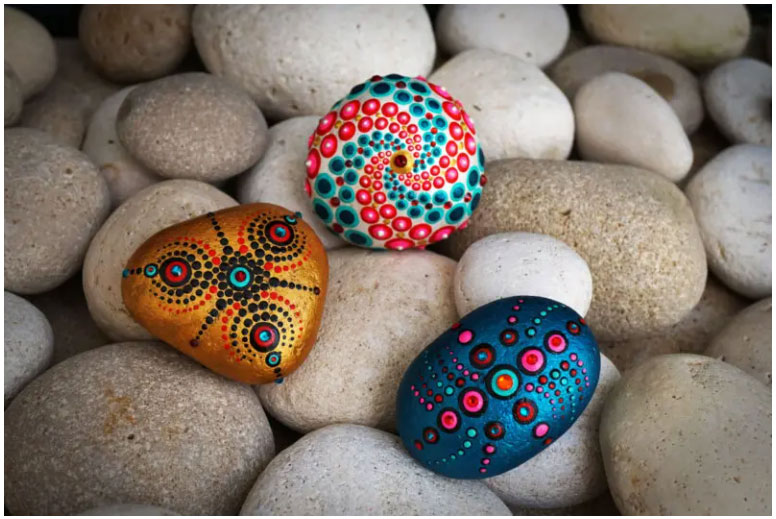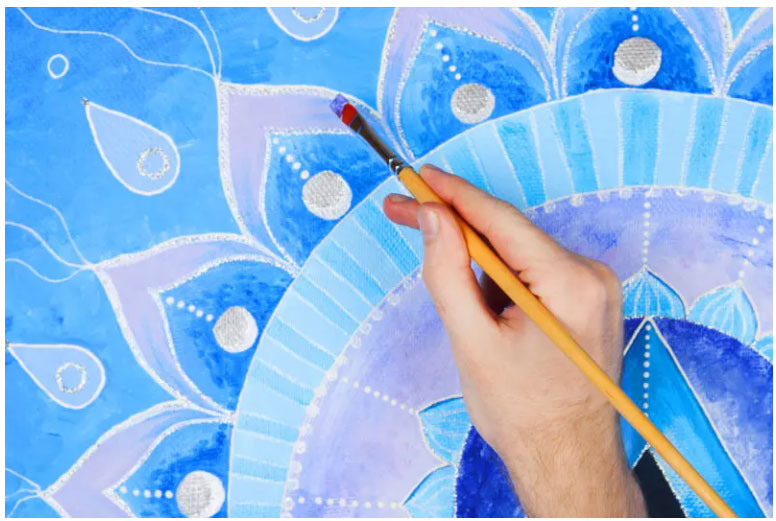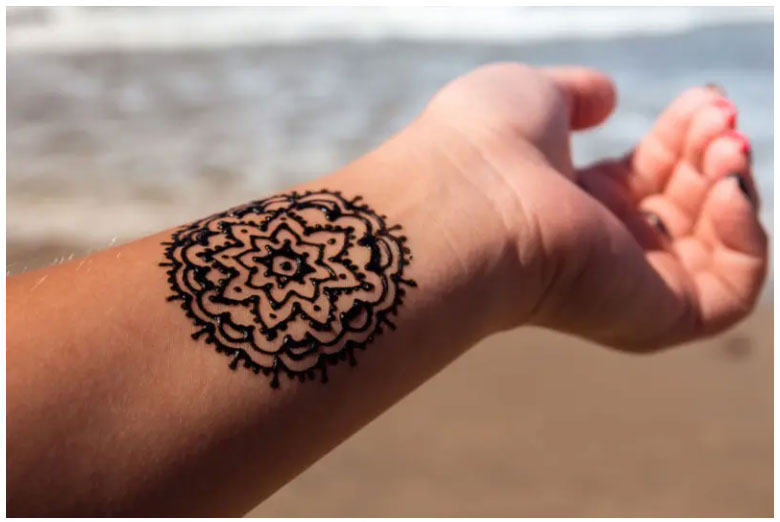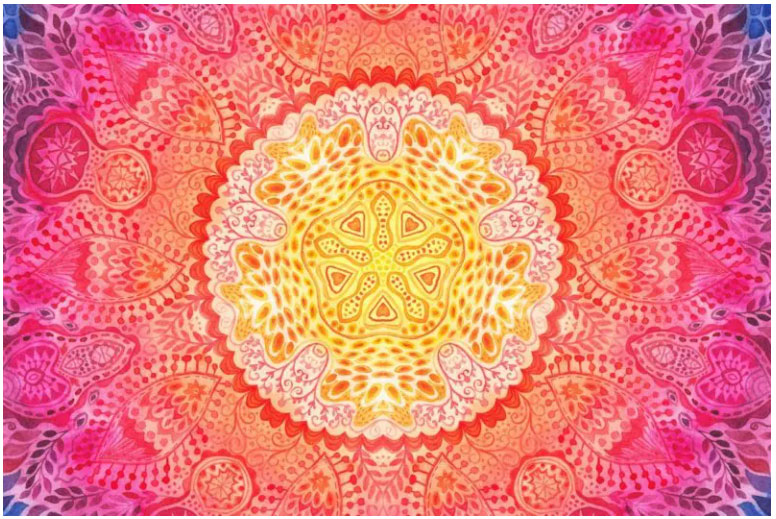Mandala Meaning
If you have ever studied Asian spiritual art, you probably know what a Mandala is. In fact, Mandala means "circle" or "discoid object" in Sanskrit. It is a geometric design that is very symbolic in Hindu and Buddhist cultures. It is said that Mandalas represent different aspects of the universe and are used as meditation instruments and symbols of prayer, especially in China, Japan and Tibet.
What is the meaning of the Mandala?
Mandala comes from Sanskrit and means "circle". Even though it may have other geometric elements such as squares or triangles within a Mandala, it always has an overall circle shape.
Mandalas offer balancing visual elements, symbolizing unity and harmony. The meaning of a Mandala depends on color, geometric elements and culture.
The purpose of the Mandala is to serve as a tool in our spiritual journey, as it symbolizes the cosmic and psychic order. It is a spiritual work of art with a concentric design. Some people call the design "sacred geometry" or "sacred circle" because of its religious meanings and effects.
The meanings and images of the Mandala are very varied. Mandalas are popular in adult coloring books because they provide calming effects. Mandalas are also ideal for meditation.
Mandalas can be used in many cultures, but are mostly associated with Buddhism and Hinduism. Mandalas have been used since the fourth century in Indonesia, Bhutan, China, Japan, India and Tibet. They were also used in the Aztec and Mayan cultures to mark time as a calendar, and as a ceremonial device such as an altar or basin in the latter.

The origin of Mandalas
Siddhartha Gautama, the founder of Buddhism, was born in the region now known as Nepal. Although there is no confirmed date of his birth, historians believe it to be around 560 BC. Siddhartha is believed to have left his kingdom after becoming aware of human suffering, where he sought enlightenment through meditation and thoughtful action.
He began to preach his philosophy throughout India, where he obtained pious followers and eventually established the first community of Buddhist monks, called "La Sangha".
As these Buddhist monks traveled the Silk Road, an ancient network of trade routes linking East and West, they brought Buddhism to other lands. They carried mandalas with them and brought the practice of painting these spiritual compositions to other parts of Asia, appearing in areas such as Tibet, China and Japan in the 4th century.
Although rooted in Buddhist culture, the Mandala soon became present in Hinduism and other religious practices. Painters of spiritual art were often pious laymen, sponsored by a sponsor. They worked sitting on the floor with a painting on their knees or in front of them with their legs crossed.
The symbols of the Mandalas
In their mysterious circular patterns, it is easy to find common symbols in all Mandalas. Traditionally, they include the presence of Buddha's mind in an abstract form, most often represented as a wheel, a tree, a flower or a jewel.
The center is a point that is interpreted as the starting point, the beginning of contemplation and devotion to the divine. From there, the point is surrounded by lines and geometric patterns that symbolize the universe, encompassed by the outer circle that represents the cyclical nature of life.

Common symbols in the Mandala include
The Eight-Spoke Wheel : The circular nature of a wheel functions as an artistic representation of a perfect universe. The eight spokes represent the eightfold path of Buddhism, a summary of the practices that lead to liberation and rebirth.
The Triangle : When facing upwards, triangles represent action and energy, and when facing downwards, they represent creativity and the pursuit of knowledge.
The Lotus Flower : Sacred symbol in Buddhist culture, the symmetry of a lotus represents balance. Just as a lotus rises from the bottom of the water towards the light, so too does a human reaching out for spiritual enlightenment and enlightenment.
The Sun : A popular basis for modern Mandala designs, the sun tends to represent the universe, often carrying meanings related to light and energy.
The Bells : Bells represent an opening and emptiness of mind to allow the entry of divine wisdom and universal clarity.
How to use a Mandala?
You already know the meaning of the Mandala. Now let's talk about how to use it. A Mandala can be used for many purposes, the following explanations will enlighten your lanterns.
The design of the Mandala must be visually appealing enough so that the mind can easily concentrate. This in turn leads to a higher consciousness.
In fact, a Mandala can be seen as hypnotic, leaving the creative hemisphere of our mind a little freer while our analytical mind rests.
That said, we can use the Mandala for meditation sessions with the aim of acquiring supreme knowledge, mainly that which resides in our inner self.
Before meditating, we must first set an intention. Normally, it is recommended that we choose a Mandala that we like. It is also important to know the meaning of the Mandala you have chosen - or to define your own meanings and intentions before you begin to concentrate.
How to use the Mandalas in meditation?
The main use of mandalas is for a form of meditation, to acquire knowledge of our inner self. Note that mandalas are symbolic images which, when used in meditation, can bring about a deep inner transformation.
The first step is therefore to choose a Mandala that you like very much. Then you focus on the intention you want to bring into your life, and then you admire the beautiful design of the Mandala by gently looking at each circle and figure of the Mandala.
If your mind starts to think about the daily stress, just bring your attention back to the beauty of the Mandala. The beauty of the Mandala should absorb all your attention by being drawn to the patterns and colors. Gradually, you will feel more relaxed and a feeling of lightness and intuitive thoughts may come over you. Allow yourself to float with it. Don't deprive yourself and let go.
And if your thoughts begin to wander, relax and refocus your attention on the Mandala. The first time you meditate on the Mandala, 5 minutes will be enough. You could gradually increase to 15 minutes as you get used to it.

The meaning of the colors of the Mandala
Indeed, colors have a particular impact on the way we see things and think. They have different functions in Buddhist spiritual art; this is especially true when it comes to Mandalas.
The Buddhist theory of color states that color is a concept of enlightenment that is usually represented by pure light. There are six main colors in religious texts of which five (all except black) represent the five personifications of the Buddha. The five colors are present in nature.
• The white that represents purity and emancipation
• Yellow means humility and renunciation
• Red represents luck, passion and accomplishment
• Blue means healing, wisdom and life
• The green that represents balance and harmony
• Black which means shadow and ignorance
Some tips for mandala therapy
In addition to its motif, the meaning of a Mandala depends mainly on its color. As we have seen previously, the coloring of a Mandala brings many benefits for physical and psychological health. Here are a few tips for experiencing the benefits of Mandala for therapeutic purposes.
What if you color your Mandala yourself?
• Once you have already chosen your design, decide which coloring medium you will use.
• Do the coloring in layers. Start by filling a shape with a light shade, then repeat as many times as you like until it reaches the shade you want.
• You can also use two pencils of different colors and mix them together to get the desired color.
• Always apply little pressure on the crayons to avoid breaking the tip.
• If you are coloring outside the lines, use a white crayon to cover it.
• Always keep in mind that there is no right or wrong color for therapy. The color combinations you choose are entirely up to you.

The benefits of the mandala
Great anti-stress
Work and family life can be a great source of stress. This is why a particular activity such as coloring the Mandala can bring you relief and calm. Since mandalas require attention and calm to color circular patterns, they can help lower the dose of cortisol in the blood which is the stress hormone. This deep concentration in coloring gives you the experience of stress relief and reduced anxiety.
Therapeutic effect
Coloring can reduce negative and unpleasant thoughts. The sacred circles of a Mandala have a therapeutic and restorative effect.
Refreshes the brain
Mandalas not only reduce anxiety, but also refresh your brain. The coloring needs both hemispheres of the brain to stay focused. This allows all areas of the brain to work in a balanced way. The complex designs of the Mandalas spark the brain to choose the color aesthetically. The coloring mandalas activate both the analytical and creative parts of the brain, improve problem-solving abilities, sharpen motor skills and strengthen the mind.
Promotes creativity
Coloring a Mandala activates your creativity. Indeed, this activity can help you take your mind out of the daily routine... Researchers believe that adults engaged in coloring are likely to rediscover their creative ideas and apply them in all areas of their lives. Once you start coloring regularly, you become excellent at choosing patterns and coloring them creatively.
Stimulates the immune system
The geometric patterns of the mandalas metaphysically represent the cosmos. Mandalas are considered by modern medicine to be a powerful healing tool and provide calm. Mandalas stimulate the immune system, improve concentration, reduce pain and promote good sleep.
They reconnect with your inner child.
Some aspects of our lives are linked to unpleasant problems that we never leave behind. Mandala Healing Therapy helps you to reconnect with your inner child and break all these negative thought patterns. This therapy helps adults to become better people by loving themselves more. Furthermore, it strengthens your self-confidence and helps you to successfully face the challenges of this world.


